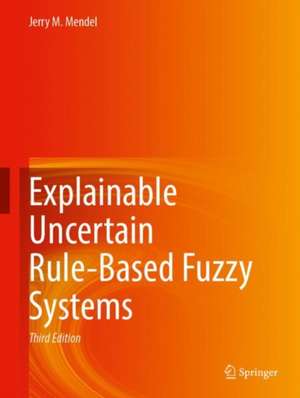Explainable Uncertain Rule-Based Fuzzy Systems
Autor Jerry M. Mendelen Limba Engleză Hardback – 2 feb 2024
Preț: 631.11 lei
Preț vechi: 788.89 lei
-20% Nou
Puncte Express: 947
Preț estimativ în valută:
120.80€ • 131.26$ • 101.54£
120.80€ • 131.26$ • 101.54£
Carte disponibilă
Livrare economică 31 martie-14 aprilie
Preluare comenzi: 021 569.72.76
Specificații
ISBN-13: 9783031353772
ISBN-10: 3031353773
Pagini: 580
Ilustrații: XXIII, 580 p. 257 illus., 231 illus. in color.
Dimensiuni: 210 x 279 mm
Greutate: 1.59 kg
Ediția:3rd ed. 2024
Editura: Springer International Publishing
Colecția Springer
Locul publicării:Cham, Switzerland
ISBN-10: 3031353773
Pagini: 580
Ilustrații: XXIII, 580 p. 257 illus., 231 illus. in color.
Dimensiuni: 210 x 279 mm
Greutate: 1.59 kg
Ediția:3rd ed. 2024
Editura: Springer International Publishing
Colecția Springer
Locul publicării:Cham, Switzerland
Cuprins
Introduction.- Part 1: Type-1 Fuzzy Sets and Systems.- Short Primers on Type-1 Fuzzy Sets and Fuzzy Logic.- Type-1 Fuzzy Logic Systems.- Part 2: Type-2 Fuzzy Sets.- Sources of Uncertainty.- Type-2 Fuzzy Sets.- Operations on and Properties OF Type-2 Fuzzy Sets.- Type-2 Relations and Compositions.- Centroid of a Type-2 Fuzzy Set: Type-Reduction.- Part 3: Type-2 Fuzzy Logic Systems.- Mamdani Interval Type-2 Fuzzy Logic Systems (IT2 FLSS).- TSK Interval Type-2 Fuzzy Logic Systems.- General Type-2 Fuzzy Logic Systems (GT2 FLSS).- Conclusion.
Notă biografică
Jerry M. Mendel received the Ph.D. degree in Electrical Engineering from the Polytechnic Institute of Brooklyn, Brooklyn, NY. Currently, he is Emeritus Professor of Electrical Engineering at the University of Southern California in Los Angeles, where he worked for 44 years. He has published close to 600 technical papers and is author and/or co-author of 12 books, including Uncertain Rule-based Fuzzy Logic Systems: Introduction and New Directions (Prentice-Hall, 2001), Perceptual Computing: Aiding People in Making Subjective Judgments (Wiley & IEEE Press, 2010), Introduction to Type-2 Fuzzy Logic Control: Theory and Application (Wiley & IEEE Press, 2014) and Uncertain Rule-based Fuzzy Systems: Introduction and New Directions, 2nd ed. (Springer, 2017). He is a Life Fellow of the IEEE, a Distinguished Member of the IEEE Control Systems Society, and a Fellow of the International Fuzzy Systems Association and the Asia-Pacific AI Association. He was President of the IEEE Control Systems Society in 1986, a member of the Administrative Committee of the IEEE Computational Intelligence Society for nine years, and Chairman of its Fuzzy Systems Technical Committee and the Computing With Words Task Force of that TC. Among his awards are the 1983 Best Transactions Paper Award of the IEEE Geoscience and Remote Sensing Society, the 1992 Signal Processing Society Paper Award, the 2002 and 2014 Transactions on Fuzzy Systems Outstanding Paper Awards, a 1984 IEEE Centennial Medal, an IEEE Third Millenium Medal, a Fuzzy Systems Pioneer Award (2008) from the IEEE Computational Intelligence Society for fundamental theoretical contributions and seminal results in fuzzy systems, and the 2021 IEEE Lotfi A. Zadeh Pioneer Award for developing and promoting type-2 fuzzy logic. As of March 27, 2023, his publications have been cited (Google Scholar) more than 63,000 times, with an h-index of 100 and an i10-index of 320.
Textul de pe ultima copertă
The third edition of this textbook presents a further updated approach to fuzzy sets and systems that can model uncertainty — i.e., “type-2” fuzzy sets and systems. The author demonstrates how to overcome the limitations of classical fuzzy sets and systems, enabling a wide range of applications, from time-series forecasting to knowledge mining to classification to control and to explainable AI (XAI). This latest edition again begins by introducing classical (type-1) fuzzy sets and systems, and then explains how they can be modified to handle uncertainty, leading to type-2 fuzzy sets and systems. New material is included about how to obtain fuzzy set word models that are needed for XAI, similarity of fuzzy sets, a quantitative methodology that lets one explain in a simple way why the different kinds of fuzzy systems have the potential for performance improvements over each other, and new parameterizations of membership functions that have the potential for achieving even greater performance for all kinds of fuzzy systems. For hands-on experience, the book provides information on accessing MATLAB, Java, and Python software to complement the content. The book features a full suite of classroom material.
Caracteristici
Provides an updated approach to fuzzy sets and systems that can model uncertainty Includes a new chapter on recent advances in type-1 and type-2 rule based fuzzy systems Features complete classroom material including end-of-chapter exercises, a solutions manual, and case studies
